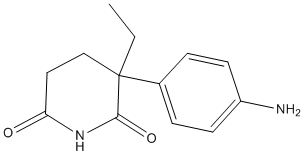All AbMole products are for research use only, cannot be used for human consumption.

Aminoglutethimide (Cytadren) is an inhibitor of adrenocortical steroid synthesis. It blocks aromatase in the generation of estrogens from androstenedione and testosterone. It also blocks the conversion of cholesterol to pregnenolone by inhibiting the enzyme P450scc and consequently decreases synthesis of all hormonally active steroids. It inhibited bovine adrenal cholesterol side-chain cleavage activity with an IC50 value of 40 μM.
| Cell Experiment | |
|---|---|
| Cell lines | Adrenocortical tumor cell line NCI-h295 |
| Preparation method | Maintaining the NCI-h295 tumor cell line in RPMI 1640 medium which is supplemented with transferrin (0.1 mg/mL), insulin (5 μg/mL), selenium (5.2 μg/mL) and 2% FCS. Incubating the cells for 48 hours with Aminoglutethimide (3, 30, 300 μM). Then examining cells by trypan blue staining for cell viability, counting with a coulter counter. For the assessment of ACTH-R mRNA, cells are harvested, and total RNA is extracted, electrophoresed, blotted and hybridized with a human ACTH-R cDNA probe. |
| Concentrations | Dissolved in 65% ethanol as a stock solution, final concentrations 3, 30, 300 μM. |
| Incubation time | 48 hours |
| Animal Experiment | |
|---|---|
| Animal models | Swiss CD1 male and female mice |
| Formulation | Dissolved in DMSO and diluted in saline. |
| Dosages | 150 mg/kg |
| Administration | Injection |
| Molecular Weight | 232.28 |
| Formula | C13H16N2O2 |
| CAS Number | 125-84-8 |
| Solubility (25°C) | DMSO 10 mg/mL |
| Storage |
Powder -20°C 3 years ; 4°C 2 years In solvent -80°C 6 months ; -20°C 1 month |
[1] G Cocconi. First generation aromatase inhibitors--aminoglutethimide and testololactone
[2] No authors listed. Lancet. Aminoglutethimide
[3] S W Hughss, et al. Aminoglutethimide: a "side-effect" turned to therapeutic advantage
| Related Products |
|---|
| DSPE-PEG-FA
DSPE-PEG2K-FA is a PEG derivative containing folic acid. DSPE-PEG2K-FA has a targeting effect and can bind to folic acid receptors in cancer cells. DSPE-PEG2K-FA forms micelles/lipid bilayers and can be used in research on targeted drug delivery systems. |
| Lifastuzumab
Lifastuzumab is a humanized anti-NaPi2b IgG1 monoclonal antibody. |
| GPVI antagonist 1
GPVI antagonist 1 is a glycoprotein VI (GPVI) platelet receptor antagonist. GPVI antagonist 1 inhibits collagen-induced platelet aggregation with an IC50 of 25.3 μM. |
| MPSD TFA
MPSD TFA (MARCKS-ED TFA) is a 25-amino acid peptide based on the effector domain sequence of the intracellular membrane protein myristoylated alanine-rich C-kinase substrate (MARCKS). MPSD TFA can sense membrane curvature and recognize phosphatidylserine. MPSD TFA can be utilized as biological probe to study membrane shape and lipid composition. |
| 4-Nitro-2,1,3-benzoselenadiazole
4-Nitro-2,1,3-benzoselenadiazole is a biochemical material that can be used in scientific research. |
All AbMole products are for research use only, cannot be used for human consumption or veterinary use. We do not provide products or services to individuals. Please comply with the intended use and do not use AbMole products for any other purpose.


Products are for research use only. Not for human use. We do not sell to patients.
© Copyright 2010-2024 AbMole BioScience. All Rights Reserved.
